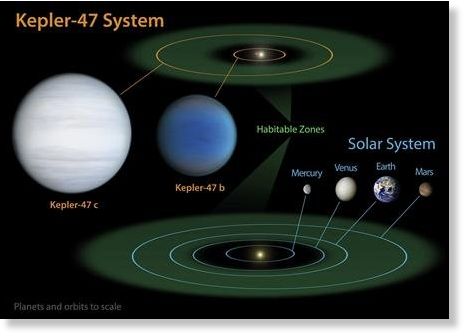
Unlike single planets orbiting single stars, the planets in the Kepler-47 system, located about 5,000 light years away in the constellation Cygnus, are flying around a "moving target," San Diego State University astronomer Jerome Orosz said in a paper published in this week's Science magazine.
As a consequence, when and how long it takes for the planets to orbit their parent stars varies, a telltale sign of so-called "circumbinary orbits."
Kepler works by detecting slight dips in the amount of light coming from target stars caused by orbiting planets passing by, or transiting, relative to the observatory's line of sight.
Last year, astronomers announced the first planet found to be orbiting a pair of stars.
The Kepler-47 family is more complex, with at least two planets circling a pair of stars that whirl around each other every 7.5 days.
One star is similar to the sun, though only 84 percent as bright. Its diminutive partner is two-thirds smaller and 175 percent dimmer.
Flying around the duo are planets Kepler-47b, which orbits in 49.5 days, and Kepler-47c, which takes 303 days to circle the parent stars.
The inner planet is about three times the size of Earth and too close to its parent stars to support life, scientists believe.
The outer world, Kepler-47c, lies within the so-called "habitable zone," where temperatures could support liquid water on the surface, provided it had a surface. Astronomers suspect Kepler-47c is a gas giant, slightly bigger than Neptune. But it could have life-friendlier moons.
Kepler scientists previously discovered four systems each having two stars and one planet. The discovery of multiple planets in a dual-star system taxes currently held theories about how planets form.
"The multi-planet nature of the Kepler-47 system establishes that despite the chaotic environment around binary stars, planetary systems can form and persist close to the binary," Orosz wrote.
Source: Reuters



Reader Comments
to our Newsletter